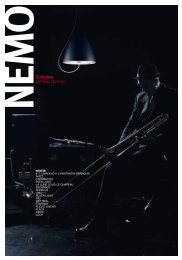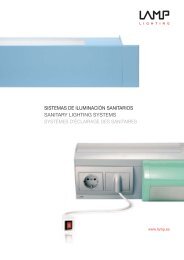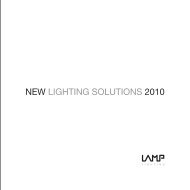WWW.XAL.COM office@xal.com XENON ARCHITECTURAL ...
WWW.XAL.COM office@xal.com XENON ARCHITECTURAL ...
WWW.XAL.COM office@xal.com XENON ARCHITECTURAL ...
Create successful ePaper yourself
Turn your PDF publications into a flip-book with our unique Google optimized e-Paper software.
fast<br />
Spaceport America, New Mexico / USA<br />
D Erst vor kurzem setzte die britische Architekturlegende<br />
Sir Norman Foster in puncto Flughäfen<br />
neue Maßstäbe: Mit dem Terminal 3 des<br />
Pekinger Flughafens errichtete sein Londoner Unternehmen<br />
Foster + Partners das derzeit größte<br />
Gebäude der Welt. Nun setzt Foster zu einem<br />
neuen Weltrekord an. Diesmal nicht, was die<br />
Größe betrifft, sondern die Flughöhe. Denn von<br />
Fosters neuestem Flughafen fliegt man nicht etwa<br />
zu einem anderen Flughafen auf Mutter Erde,<br />
sondern mit dem Raumschiff ins All. Der derzeit<br />
mitten in der Wüste von New Mexico entstehende<br />
Spaceport America ist der erste kommerzielle<br />
Weltraumflughafen dieses Planeten: bereits ab<br />
2009 sollen von hier aus die ersten, exklusiven<br />
privaten Weltraumreisen im vom französischen<br />
Stardesigner Philippe Starck designten Space<br />
ShipTwo starten. Vorerst nur für VIP-Passagiere,<br />
für die die ersten Flüge reserviert sind, ab 2010<br />
auch für Otto Normalraumfahrer, zu einem Ticketpreis<br />
von 200.000 Dollar. Hinter dem wie ein<br />
Science-Fiction-Märchen anmutenden Projekt<br />
steckt kein Geringerer als Richard Branson, Milliardär,<br />
Abenteurer, Ballonfahrer und Betreiber der<br />
Fluglinie Virgin, der nun mit seiner neuen Suborbit-Fluggesellschaft<br />
Virgin Galactic den Weltraumtourismus<br />
als neues Geschäftsfeld entdeckt<br />
hat. Ende 2009/Anfang 2010 sollen vom Spaceport<br />
America die ersten Freizeit-Astronauten<br />
abheben, zu einem Flug, der das SpaceShipTwo<br />
zunächst per Trägerflugzeug in 15 Kilometer<br />
Höhe bringt, und denn per Raketentriebwerk<br />
in 110 Kilometer Höhe steigen und in den Sub-<br />
Erdorbit schweben lässt (als Astronaut gilt offiziell,<br />
wer 100 Kilometer Flughöhe erreicht hat).<br />
Nach vier Minuten Schwerelosigkeit in der Kabine<br />
des Raumschiffs geht es zurück auf die Erde.<br />
Ähnlich spektakulär wie der Flug präsentiert sich<br />
auch der Spaceport, der von Foster + Partners<br />
gemeinsam mit dem US-Designunternehmen<br />
URS Corp. gestaltet wurde. Ganz im Gegensatz<br />
zu dem hochfliegenden Projekt verschwindet<br />
die organisch geschwungene Betonschale des<br />
Gebäudes, abgesehen von einer breiten Panorama-Fensterfront<br />
mit Ausblick auf die Startbahn,<br />
nahezu unterirdisch unter einer Erdböschung.<br />
Keine architektonische Extravaganz, sondern<br />
eine dem extremen Wüstenklima und seinen<br />
Temperaturschwankungen angepasste Bauweise,<br />
die auf der Gewinnung von Passivenergie<br />
für die Klimatisierung setzt, Strom durch Sonnenpaneele<br />
gewinnt und auch das wertvolle Wasser<br />
in einer hauseigenen Recycling-Anlage aufbereitet.<br />
Neben Terminals und Passagierlounges<br />
beherbergt der Spaceport auch Hangars für zwei<br />
Trägerflugzeuge und fünf Raumschiffe sowie die<br />
hauseigene Raumfahrerschule, die Passagiere für<br />
den Weltraumausflug und die Schwerelosigkeit<br />
entsprechend vorbereitet. Raumflug-Reservierungen<br />
(gegen Anzahlung von 20.000 Dollar) ab<br />
sofort unter virgingalactic.<strong>com</strong>.<br />
E British architecture legend Sir Norman Foster<br />
recently set new standards for airports: His<br />
London-based <strong>com</strong>pany Foster + Partners built<br />
the world’s largest building – Terminal 3 of Beijing<br />
Airport. Now Foster is going for a new world<br />
record. This time not in terms of size, but altitude.<br />
People taking off from Foster’s newest airport<br />
will not be flying to another airport on Mother<br />
Earth, but on board a spaceship into outer space.<br />
Spaceport America, which is currently being constructed<br />
in the heart of the New Mexico desert, is<br />
the first <strong>com</strong>mercial space airport on the planet:<br />
The first, exclusively private trips into space in<br />
SpaceShipTwo, designed by top French designer<br />
Philippe Starck, are scheduled to depart from<br />
here in 2009. Initially only for VIP passengers, for<br />
whom the first flights are reserved, and from 2010<br />
for Joe Regular Astronaut, for a ticket price of<br />
200,000 dollars. Behind the project, which <strong>com</strong>es<br />
straight out of a science fiction fantasy, is none<br />
other than Richard Branson, billionaire, adventurer,<br />
balloon pilot and operator of airline Virgin<br />
Atlantic, who has now discovered space tourism<br />
as a new business field with his new sub-orbital<br />
flight <strong>com</strong>pany, Virgin Galactic. Some time in late<br />
2009 or early 2010, the first leisure astronauts<br />
should lift off from Spaceport America on a flight<br />
that first takes SpaceShipTwo on a carrier aircraft<br />
to a height of 15 kilometres, from where it will<br />
climb under rocket power to an altitude of 110<br />
kilometres to float in sub-earth orbit (an astronaut<br />
is officially anyone who reaches an altitude of 100<br />
kilometres). After four minutes of weightlessness<br />
in the spaceship cabin it is time to return to earth.<br />
Just as spectacular as the flight is the Spaceport,<br />
which has been designed by Foster + Partners<br />
together with US design <strong>com</strong>pany URS Corp.<br />
In <strong>com</strong>plete contrast to the high-flying project,<br />
the building’s organically floating concrete shell<br />
disappears, apart from a wide panoramic window<br />
façade with a view of the runway, almost subterraneously<br />
beneath an earth rampart. This is not<br />
architectural extravagance, but a building method<br />
adapted to the extreme desert climate and its<br />
temperature fluctuations, which focuses on the<br />
extraction of passive energy for the air conditioning,<br />
generates power through solar panels and<br />
also treats precious water in its own recycling<br />
plant. In addition to terminals and passenger<br />
lounges, the Spaceport also houses hangars for<br />
two carrier aircraft and five spaceships as well as<br />
the <strong>com</strong>pany’s own astronaut school, which gives<br />
passengers the preparation they need for the<br />
excursion into space and weightlessness. Space<br />
flight reservations (for a deposit of 20,000 dollars)<br />
can be made now at virginatlantic.<strong>com</strong>.<br />
I Recentemente l’architetto britannico Sir Norman<br />
Foster, uno dei maestri dell’architettura contemporanea,<br />
ha definito nuovi parametri in fatto<br />
di aeroporti. Con il Terminal 3 dell’aeroporto di<br />
Pechino, il suo studio londinese Foster + Partners<br />
ha realizzato quello che attualmente è l’edificio<br />
più grande del mondo. Ora Foster si accinge a<br />
conquistare un nuovo primato mondiale, non<br />
tanto per quanto riguarda le dimensioni planimetriche,<br />
ma piuttosto per l’altezza di volo. Dal nuovissimo<br />
aeroporto di Foster, infatti, non si volerà<br />
verso un altro aeroporto del globo terrestre, ma<br />
si partirà con l’astronave alla volta dello spazio.<br />
Lo Spaceport America che sta sorgendo attualmente<br />
nel mezzo del deserto del New Mexico è il<br />
primo aeroporto <strong>com</strong>merciale di questo pianeta<br />
con destinazione il cosmo. Già dal 2009 dovrebbero<br />
partire da qui i primi esclusivi viaggi cosmici<br />
privati a bordo della SpaceShipTwo, disegnata<br />
dal famoso architetto-designer francese Philippe<br />
Starck. In un primo tempo soltanto per i passeggeri<br />
VIP, per i quali sono già prenotati i primi<br />
voli, ma dal 2010 anche per viaggiatori spaziali<br />
“normali”, a un prezzo del biglietto di 200.000<br />
dollari. Dietro questo progetto fantascientifico, si<br />
nasconde niente meno che Richard Branson, miliardario,<br />
avventuriero, aeronauta e gestore della<br />
linea area Virgin, che ora con la sua nuova <strong>com</strong>pagnia<br />
aerea suborbitale Virgin Galactic ha scoperto<br />
il turismo spaziale <strong>com</strong>e nuovo campo di<br />
attività. Verso la fine del 2009 o l’inizio del 2010,<br />
dallo Spaceport America dovrebbero decollare i<br />
primi astronauti del tempo libero, per un volo che<br />
porterà la SpaceShipTwo prima a 15 chilometri di<br />
altezza, trasportata da un aereo cargo, e poi, con<br />
propulsione a razzo, a 110 chilometri di altezza,<br />
dove si librerà nell’orbita suborbitale (ufficialmente<br />
un astronauta è considerato tale dopo aver<br />
raggiunto un’altezza di volo di 100 chilometri).<br />
Dopo quattro minuti di assenza di gravità nella<br />
cabina dell’astronave, si fa ritorno sulla terra.<br />
Spettacolare quanto il volo appare lo Spaceport,<br />
progettato da Foster + Partners in collaborazione<br />
con lo studio di architetti associati statunitense<br />
URS Corp. Del tutto in contrasto con un progetto<br />
che punta a volare alto, a parte un ampio<br />
fronte vetrato con vista panoramica sulla pista<br />
di decollo, il guscio di calcestruzzo dell’edificio,<br />
con la sua forma organica, s<strong>com</strong>pare quasi sotto<br />
terra, insinuandosi in colline artificiali. Nessuna<br />
stravaganza architettonica, ma un <strong>com</strong>plesso<br />
adattato alle condizioni climatiche estreme e alle<br />
escursioni termiche del deserto, che punta sulla<br />
produzione di energia passiva per l’impianto di<br />
condizionamento, produce corrente elettrica con<br />
pannelli solari e tratta anche la preziosissima<br />
acqua in un impianto di riciclaggio interno. Oltre<br />
ai terminal e ai salottini per i passeggeri, lo Spaceport<br />
ospita anche hangar per due aerei cargo e<br />
cinque astronavi <strong>com</strong>e pure la scuola cosmonautica<br />
interna, che prepara i passeggeri per il volo<br />
nel cosmo e per l’assenza di gravità. Chi vuole<br />
prenotarsi per il volo spaziale (dietro pagamento<br />
di un acconto di 20.000 dollari) può farlo subito<br />
su virgingalactic.<strong>com</strong>.<br />
<strong>XENON</strong> <strong>ARCHITECTURAL</strong> LIGHTING<br />
Magazine 15 05








![Lataa tästä Building06 nettikirje [PDF] [591.72 KB] - Teclux](https://img.yumpu.com/41499677/1/184x260/lataa-tasta-building06-nettikirje-pdf-59172-kb-teclux.jpg?quality=85)







